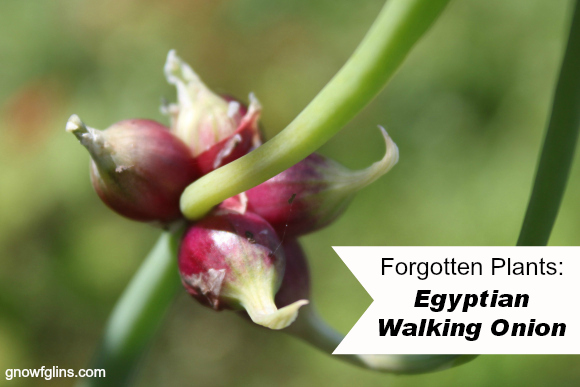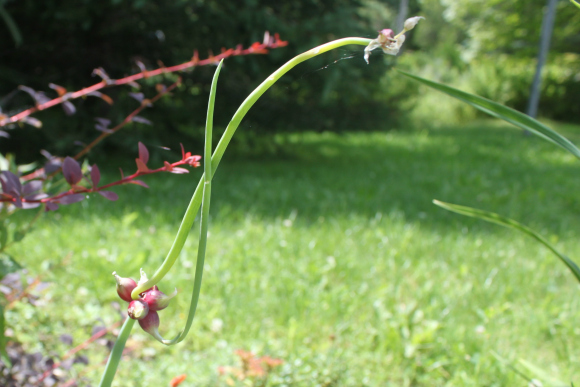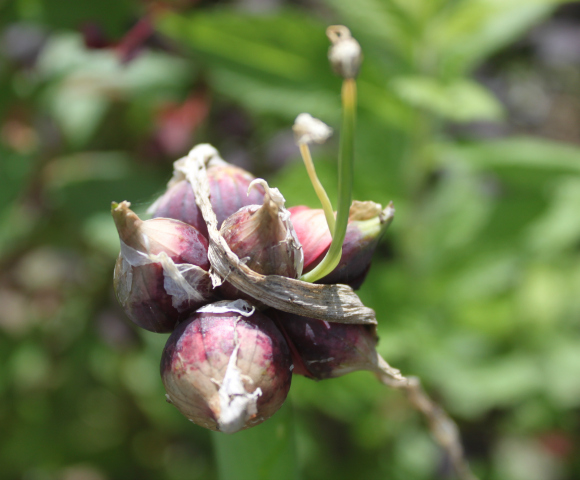
Forgotten Plants: once prolific in the kitchen gardens of our ancestors, but now so rare that the average person might never have even heard of them. Many of these deserve to find space in our gardens again! This is the third post in the series.
Egyptian Walking Onions. How can you not love a plant with such an interesting name? Although my own walking onion patch is just beginning to thrive, I knew I had to include them as part of the series when I found a bundle drying over the fire in one of the farmhouses that make up our local historical settlement.
In one of those defining “I must really be a gardener” moments, I started frantically searching for a pen and covered my settlement map with notes about the many herbs and plants that they had hanging to dry. (I was happy to see Borage hanging there beside the onions, too!)
History of Egyptian Walking Onions
Although an Egyptian origin might seem obvious, and onions were an important part of Ancient Egyptian culture, there is no record of this particular onion being around at that time — or, in fact, in Egypt at any time. They are called walking onions due to their unique way of replanting themselves; as their heavy top sets fall and then grow into new plants, they literally “walk” across your garden.
I love this interpretation, that, perhaps, the plant got its name because it “walks like an Egyptian.” It is also known by the names “tree onion,” “perennial onion,” and “winter onion.” I do know, from my settlement visit, that at least around here, you would have found these plants growing in a kitchen garden in the early 1800s.
How Does Your Onion Grow?
I purchased 6 topsets to plant in my garden 3 years ago, had 3 survive the winter that year, and have only 2 plants left to create topsets this year, so I would not classify the plant as foolproof (but 3 years ago I was still a pretty newbie gardener, too, so gardener error may have come into play!).
Fall plantings are ideal, but walking onions can be successfully planted throughout the growing season. They are hardy to zone 3 and prefer a sunny location. Once past the first year — when they grow only stalks — they will send up green stalks in the spring, which will form topsets, or mini onions, on the tops. In the fall, the green stalks will die back and the topsets will fall to the ground, becoming the bulbs for next year’s plants.
Harvesting and Cooking
From root to tip, this plant is entirely edible and can be used as you would any onion, although it must be noted that the flavour is much stronger. The green leaves can be cut and used as scallions, and the topsets and bulb itself can replace onions in any dish. The tiny onions are often served pickled and this is starting to gain some popularity among gourmet chefs.
On my visit to the historical settlement, I was told that the onions are good for lowering blood sugar, clearing congestion due to colds, and improving blood pressure.
The green stalks can be harvested at any time, and will grow back throughout the growing season. But be careful not to harvest the stalk with the topset as you will want those to develop into yummy onion bulbs! Once the leaves have yellowed in the fall, both the topsets and onion bulb can be harvested for use. Be sure to leave some to grow new plants in the spring!
As my own onion patch is so small, I have yet to do a lot of cooking with this plant, However, I know I do like the greens sprinkled into soups and salads. As I have recently moved to a new house and had to leave my garden behind, this will be one plant that I will definitely be planting at the new house this fall. Perennial onions outside my back door? Yes, please!
Have you ever grown Egyptian Walking Onions? What are your favourite ways to use them?
...without giving up the foods you love or spending all day in the kitchen!

2 free books:
Eat God's Way
Ditch the Standard American Diet, get healthier & happier, and save money on groceries...
We only recommend products and services we wholeheartedly endorse. This post may contain special links through which we earn a small commission if you make a purchase (though your price is the same).




What a great post. I love my walking onions. They are thriving, huge, beautiful and I do nothing to take care of them. They thrive in my garden bed of 80% straw and FULL sun. We harvest when they look full, cutting the greens to use as scallions and the white bulbs to replace onions. We freeze them. The flavor is lovely. Stir fry, soup, Mexican food, pizza, bread, roasts, over potatoes, EVERYTHING. We love them!! Zone 5
I can’t wait until my patch has grown large enough to use in all of these ways! Thanks for all of the great ideas!
How do you go about freezing them? We just moved to a new home in Upstate New York and one of the gardens is filled with these onions. I didn’t even know what they were until reading about them, so anyone that can share some great tips for recipes and other things, I’d really appreciate. For now, would love to know the proper way of freezing them.
Merrilee, I don’t have enough to freeze (yet) but I would assume that you would just chop them up and put them in the freezer, the way you would with a regular onion.
Hello, we use the leaves, too sets, and early spring bulbs. I am not much of a fan of the later season bulb do to the stiff grainy texture. I always feel like there should be something to do with this big luscious stalks but they are to firm to use green or fresh cooked for my taste. So from someone who sounds like they have experimented with them a lot …
Do you do any thing with the stalk? Have you ever pickled the stalks in sliced rings? I had the thought after having pickled seaweed rings
Do you use the larger/older mother bulbs after spring?
Have you used these to make onion powder? I thought they may work well due to the stronger flavor.
Interesting post for this forgotten plant of yester-years which I never knew existed.
I never knew they existed either until I found them in a local seed catalogue. I was intrigued enough to give them a try and I’m glad I did!
I was just given some bulbs from a friend to start some. I’m really looking forward to them ~ I love anything perennial. 🙂
I am a lover of perennials, too. Enjoy! 🙂
My walking onions live with roses and strawberries in a flowerbed. There are always many bulblets to give away each Spring when I clean-out the bed. I love having the green onions in time for Easter in Zone 3/4.
I’m glad to hear that your onions are friends with your roses, as I just planted my bulbs next to a rose bush in our new yard. And fresh green onions in time for Easter! That would be lovely!
I was given some walking onions. Kinda plopped them in the ground and forgot about them. They are thriving (and walking!) Cooked with them for the first time recently. Very nice flavor. Thanks for the post 🙂
Don’t you just love gifts that keep on growing? 🙂
I love this series! Thanks for your work!
Thank you Carolyn! I love learning all of this so it’s just fun to share! 🙂
When we moved into our current house there were some of these and I had no idea what they were. I did eventually figure out that the stalks tasted like green onions. But then my amateur gardening skills killed them, and now I haven’t been able to find them since. 🙁
We’ve all made mistakes as gardeners, it’s all part of the process. I have never come across these onions in any of our local gardening stores, but ordered mine from a seed catalogue, so perhaps a local seed company might carry them? This is my go-to for just about everything I can’t find locally: http://www.richters.com/Web_store/web_store.cgi?searchterm=egyptian+onions&search_catalogue_button=Go They’re a fun plant and worth looking for!
I love mine. The bulbs are delicious. My most memorable meal with them was frying in butter with scallops, but they can be used for anything. And they will keep into winter in the coldroom. The greens are great too.
I propagate my walking onions by doing some of the walking myself, sticking the top bulbs in the ground wherever I want them to grow. Because onions have pest repellant properties, I plant them around fruit trees and bushes. They’re a great part of a perennial polyculture.
That’s great to know that they will keep in the coldroom! I can’t wait for mine to start growing again. Thanks for sharing your tips!
For those near the Colorado Springs, CO area – the Good Earth Garden Center on Walnut St sells Egyptian Walking Onion starter plants (at least they did last season). Pretty sure they also sell some of the other plants in the Forgotten Plants series like Lovage and Borage – they are really good at offering somewhat “obscure” plants and herbs. Their stock is amazing quality, you may pay a little more, but it’s oh so worth it!
Just as an FYI to others looking for places to buy non-GMO / heirloom seeds, check out Baker Creek Heirloom Seeds (www.rareseeds.com) and My Patriot Supply (www.mypatriotsupply.com) Baker Creek has seeds for everything mentioned so far except for the Eqyptain Walking Onion.
Thank you thank you thank you for this series!!! I’m really looking forward to your next installment!
Thanks again, Julie for your tips on where to find forgotten plants! I am only familiar with Canadian sources, so I value your input. I am currently writing the “Spotlight on Herbs” series, but I do hope to come back to Forgotten Plants at some point in the future. There are so many out there worthy of being in our gardens!
A friend shared a giant bag of these with me last year and I planted them in my herb garden. They’re thriving now and just starting to form those wonderful curly tops. I love the tall structural appearance they lend to the garden. Mine are situated between a large, silvery sage plant (currently blooming) and a new planting of purple and sweet basils. So far, I’ve only used a few green shoots in potato salads and omelets. I look forward to pickling some bulblets with my bread & butter cukes later in the summer. I’m so tickled to have “lucked into” this plant!
A lady selling veggies on the side of the road gave me a set of 3 about 3 years ago-they are thriving. I love to watch them when the pods form and the alien looking arms come out!! I use them as I would green onions (the tops) and the bulbs as onions. There is a slightly different taste and texture. Mine are kept in a raised bed planter on my deck and have “walked” right off into the yard!!
My mom gave me some of these several years ago, and they continue to thrive. They are now one of things I look forward to in the spring. I love chopping them up and mixing them with hashbrowns. Great way to start my day. I loved learning more about their history. They are just now forming their tops with little baby onions on them….I think I may end up writing a blog post about them as well. if you don’t mind, I would love to link it to your post. Sincerely. DM
Hi DM, They certainly are a wonderful plant, aren’t thy? Feel free to link when you write your post. 🙂
I have these mixed wth my rhubarb, yarrow and camouflage (weeds). Not much fazes them once they get established. I brought a few sets from my grandparents farm where they were grown in pretty much the same conditions, back behind the garage next to a stock tank. I just tossed them on the edge of my garden on the north side of the lot. Several years later, they have walked half-way to the other side! They taste best in the spring – the stalk can get a little fibrous and the bulbs can get pretty hot, depending on the weather. I am finally getting enough to use some of the bulb-lets in my pickling projects this year.
I’ve had these onions for years–used them for flower arranging. In the early summer, before the bulblets get too heavy, they sprout stems that spiral in interesting ways and the double-stem with the interrupting red parts provides interesting material for modern flower arrangements (use a pin-holder, not oasis).
A few years ago I let them go in my perennial garden. A mistake. They belong in the BACK, not the front of the garden. They are interesting in the border, but don’t give them front stage!
In late summer (now) the stem by bulb in ground can be woody–plan on using a knife in order to prepare the salvageable parts for your supper. The hollow green stem is also pretty woody at this time, but you can stew it, then remove it if you’re making broth or something.
i have given away so many of these of these ( plus many others) this is an heirloom plant and as I only grow heirloom plants it is a treasure.
Chopped and mixed with mashed potatoes it turns a mundane dish into a delight.
Great history! I love chopping up these onions with some green bell pepper and garlic chive ( and whatever else I have growing that sounds good), drying them all together in the oven and then using them all year long as salad toppers and in soups and other dishes.
I have hada some of these for a few years now but didn’t know which of them to use. I am now going to the garden pick some for dinner here tonight thank you for all your tips.q
I find it best to dig them up every couple years and split them. You will know when, dig, split the bulbs that are already mostly split but together. Replant with new spacing.
I find if you split the top bulbs in half and give them a quick fry, they splay apart, then add them to an omelet along withe other fresh stuff from the garden.
I love my walking onions! My friend gave me some bulbils a few years ago and I now have a 4′ x 4′ bed full of them. I just came in from collecting some of the top sets to replant so that I can start harvesting the mature onions to use in my cooking. I am definitely going to try adding the little top sets to my bread and butter pickles this year too!
My husband brought home 4 tiny red onion bulbs 3 years ago. He was helping one of his retired High School teachers tend his garden. Mr. B had grown these onions for over 50 years. My Hubby was so excited to tell me about them and how they grow and spread. We have not been disappointed! Our onion patch has grown to the point that we need grow no others. We left them to just go and grow for 2 years and this year is amazing. We have the “spider leg” tops already. Ours are at least 4 feet tall. If you want an amazing, no maintenance onion, these are it. We live between Seneca and Keuka Lakes. If local and would like to try them, we do share! Grow to Eat, Eat to Live!
Howdy everyone! I’ve been growing walking Egyptian onions for nearly 8 years. It is one of my favorite wild type onions and I have all the wild ones. I absolutely love onions for both medicine and culinary.
They grow wild here .. I used them for landscaping the lot next door. They are perenial come up every year and spread very easily. They sees will germinate pretty much any were
I wish I knew where my deceased brother got his but his garden was full of them – millions! We took some when his house went into foreclosure. The bank sent someone to cut the lawn all summer. They mowed them all down!
Mine are growing nicely in a raised bed.
Thank you for the cooking ideas. I think of my brother every time I see the plsnts.
I bought a plant at the Farmers Market last year and didn’t know what to expect. It is flourishing now and I’m using the green stems. The bulblets are abundant and now I know how to plant them. Thank you!